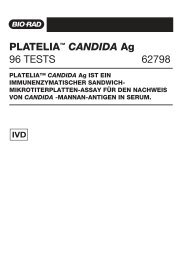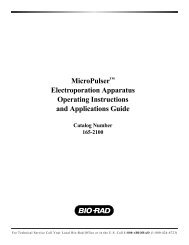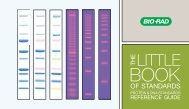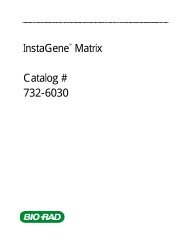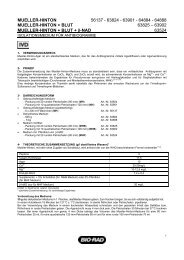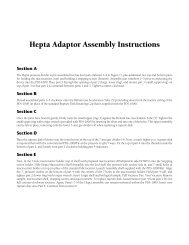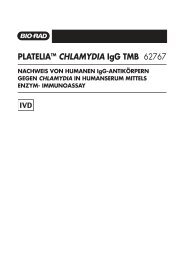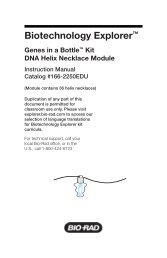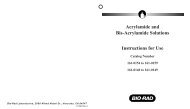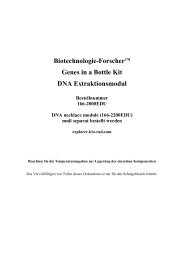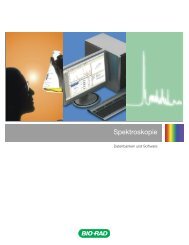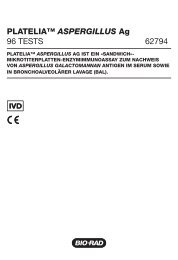Protein Expression and Purification Series - Bio-Rad
Protein Expression and Purification Series - Bio-Rad
Protein Expression and Purification Series - Bio-Rad
Create successful ePaper yourself
Turn your PDF publications into a flip-book with our unique Google optimized e-Paper software.
<strong>Protein</strong> <strong>Expression</strong> <strong>and</strong> <strong>Purification</strong> <strong>Series</strong><br />
Separating Soluble from Insoluble Induced Cell Fractions <strong>and</strong><br />
Preparing SDS-PAGE Samples<br />
Student Workstations<br />
Each student team requires the following items to separate soluble from insoluble lysate fractions <strong>and</strong><br />
prepare soluble <strong>and</strong> insoluble fraction samples for SDS-PAGE analysis:<br />
Material Needed for Each Workstation Quantity<br />
Thawed cell lysate 1 ml<br />
Lysis buffer 2 1 ml<br />
Screwcap microcentrifuge tube, 1.5 ml 2<br />
Microcentrifuge tubes, 2 ml 3<br />
Laemmli sample buffer (left over from the previous activity) 1 ml<br />
20–200 µl adjustable-volume micropipet <strong>and</strong> tips 1<br />
100–1,000 µl adjustable-volume micropipet <strong>and</strong> tips 1<br />
10 ml syringe 1<br />
22 gauge syringe needle 1<br />
Marking pen 1<br />
Common Workstation Quantity<br />
Water bath or dry bath set to 95°C 1<br />
Microcentrifuge with variable speed setting >16,000 x g 1<br />
Separate soluble from insoluble cell lysate components<br />
1. Make sure that your lysate is balanced with either another student’s lysate fraction or with a<br />
microcentrifuge tube filled with water.<br />
2.<br />
Separate the insoluble fraction of the lysed cells from the soluble fraction by centrifugation at<br />
16,000 x g for 20 minutes.<br />
3. Label a clean 2 ml microcentrifuge tube “ Soluble fraction” with your initials. Gently pour the<br />
supernatant from the “Lysed Cells” tube into the “Soluble fraction” tube being very careful not to<br />
decant any of the insoluble fraction (the opaque, viscous blob that is mainly composed of genomic<br />
DNA) into your soluble fraction.<br />
Note: The insoluble fraction does not necessarily adhere to the tube so extreme care is needed when<br />
decanting.<br />
4. Relabel the “ Lysed Cells” microcentrifuge tube containing the remaining insoluble fraction “Insoluble<br />
fraction.”<br />
5. Add 1 ml of Lysis buffer 2 to the “Insoluble fraction” tube <strong>and</strong> resuspend the pellet by shearing with<br />
a syringe needle.<br />
Note: The insoluble fraction contains a large quantity of genomic DNA that can be quite viscous,<br />
making resuspension difficult. Using a 22 gauge needle, the insoluble fraction can be pulled up into a<br />
3 ml syringe <strong>and</strong> expelled from the syringe into a clean tube multiple times to decrease the viscosity of<br />
the DNA. Ensure that the needle is disposed of properly in a sharps container.<br />
Remove 50 µl of “<br />
6. Soluble fraction” <strong>and</strong> place it in a clean 1.5 ml screwcap microcentrifuge tube<br />
labeled “Soluble PAGE” with your initials. Add 50 µl Laemmli sample buffer <strong>and</strong> mix thoroughly.<br />
Chapter 4: 11 ml Culture Protocol for<br />
Centrifugation <strong>Purification</strong><br />
99<br />
CHAPTER 4<br />
11 ml CULTURE<br />
PROTOCOL




